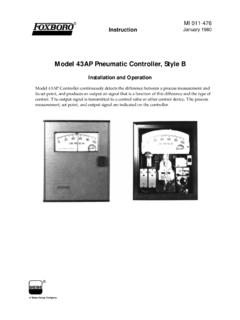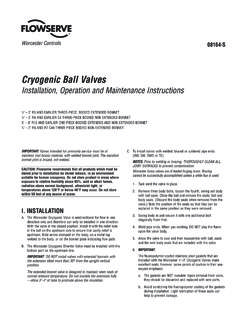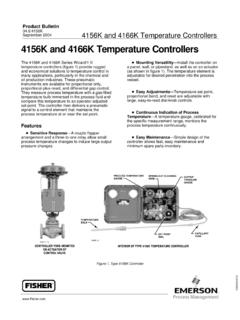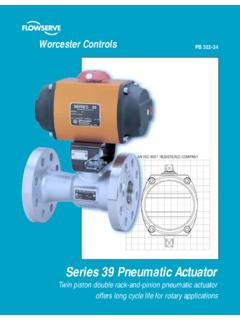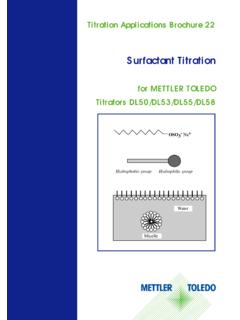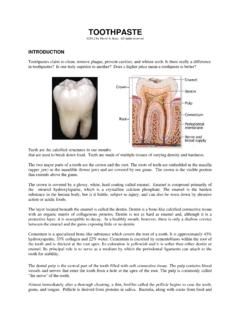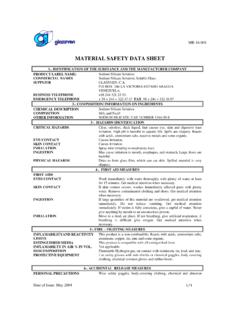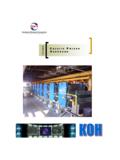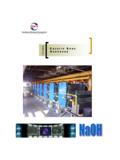Transcription of BULLETIN CWT-201 PAGE 1 OF 2 5C CLEANING & …
1 BULLETIN CWT-201 PAGE 1 OF 2 5C CLEANING & water treatment instructions closed HOT water BOILER HEATING SYSTEMS I. GENERAL DESCRIPTION ON A closed HOT water HEATING SYSTEM A closed hot water system is one where the hot water boiler, piping and the heat exchange or radiation units are filled with water and tightly sealed from leaks and outside air. The expansion tank maintains the proper proportion of air and water and serves as an area for water expansion during the heating cycle. An ideal closed system is one with no leaks and where no air or water are added or released. If this type of system is initially clean, properly conditioned and maintained against leaks, it will provide efficient and long life service. The water in the system should never be drained unless repairs, changes in the system or dirty system water make it necessary.
2 Changing of the water or adding untreated water in the system (which contains lime and sediment that increases the corrosion and scale possibility), upsets the balance of air and water . water never looses its heating transfer efficiency unless contaminated by foreign matter. water in a closed heating system improves with age and should not be changed unless absolutely necessary. II. NEW INSTALLATION OF closed HOT water HEATING SYSTEMS Every closed hot water system should be properly cleaned when the installation is completed and before putting the system in operation. This includes the boiler and the entire piping system. During installation, most systems become contaminated by pipe dope, thread cutting oils, soldering flux, rust preventives or dirt in the pipe and fittings.
3 There are frequently sufficient quantities of these contaminates that break down chemically causing gas formation and acid in the system water . Once the system is contaminated, deterioration continues, leaks develop and water losses increase which may cause serious damage due to the scaling or corrosion of the boiler. To eliminate this potential hazard, the system must be initially cleaned and water conditioned when placed in operation. (See Page 2, Paragraphs IV & V). During the first month, supplemental inhibitors such as sodium nitrate and borate or phosphates and silicates are recommended to build a thin film coating on the tubes and piping. Protect the system from slime or organic growth. We recommend operating the system normally with the make-up water valve closed so system leaks will result in a low water condition.
4 Thus operational personnel will be quickly made aware of any system leaks and they can effect repairs. III. EXISTING closed HOT water HEATING SYSTEMS Existing closed hot water systems should not be drained or cleaned, unless they become dirty or if it is necessary to do so for repairs or changes. Flushing and draining necessitates adding of make-up water , which may cause corrosion, scale and other problems. The following are the indications that an existing system needs repair or CLEANING : 1. Visible pump or other system component leaking. 2. Scale formation on the outside of pipe, fittings, valves or sight glass openings. 3. System in need of constant make-up water . This can be determined by closing water make-up valve and monitoring sight glass on expansion tank.
5 4. Obviously discolored, murky, dirty, or rusty water . 5. Vent gases at high points in the system. These will ignite and burn with an almost invisible blue flame. 6. A pH or alkalinity test with a pH reading below 7. (Below 7 pH indicates that the system water is acid. The recommended pH level is between 8 to 9). A system that is acid will usually have one or more of the following symptoms: a. Gas formations (air troubles). b. Pump seal and gland problems. c. Air vent valves sticking or leaking. d. Frequent relief valve operation. e. Pipe joint CWT-201 PAGE 2 OF 2 5C CLEANING & water treatment instructions closed HOT water BOILER HEATING SYSTEMS IV. CLEANING OF A HOT water SYSTEM CLEANING a hot water system is neither difficult nor expensive when the proper procedure is followed.
6 For proper CLEANING use Parker Clean-1 chemical or equal as recommended for such purpose and according to each supplier's procedure: 1. For new installations, add a one pound can of Parker Clean-1 for each 50 gallons of water in the system. Dissolve one pint of Clean-1 in one gallon of water and pour into air space of expansion tank. For existing installations, use Parker Solve-1 in the same manner. 2. Fill, vent and circulate the system with the CLEANING solution at approximately 160 - 175 for 2 to 4 hours. 3. Completely drain the CLEANING solution from the boiler and system and flush with clean water to completely remove all CLEANING solutions. 4. Fill and vent the system again and fire the boiler to 150 for 30 minutes to one hour.
7 5. Completely drain the rinse water and flush with water until the drain water is clear and thoroughly clean. 6. Refill the system to the proper water level. Vent air in the expansion tank and resume normal operation. V. water treatment FOR A HOT water HEATING SYSTEM The system must be thoroughly cleaned before effective control can be maintained. Once the system is cleaned, a liquid water treatment is recommended to prevent scale, corrosion and foaming. A liquid treatment should be used to prevent damage to the pump seal. Parker Boiler Control or equal should be used to properly maintain the system. 1. Shake well before using. 2. Add one quart minimum of Parker Boiler Control for each 50 gallons of water in the system. This liquid should be poured directly into the expansion tank of the system.
8 Parker Boiler Control will raise the pH to the safe recommended level of to 3. Carefully maintain the system to eliminate the loss of water due to leakage in pipes, valves, fittings, seals and packing glands. 4. A clean, neutral hot water system need never be drained except in an emergency or due to necessary servicing of the equipment. If the system is drained, Parker Boiler Control should be added as above instructions 1-2. 5. If no make-up water is added, additional treatment is not necessary unless determined from an analysis of the boiler and system water . If make-up water is added, all leaks should be immediately repaired and Parker Boiler Control added, use 1/2 pint for each 15 gallons of make-up water . Notes: On systems using ethylene glycols, an inhibited non-automotive grade should be used (the recommended pH level is 8-10).
9 When using ethylene glycols, a supplemental inhibitor package of sodium nitrate and borate is recommended at startup. Protect the system from slime or organic growth.
